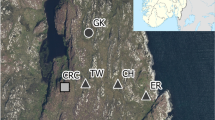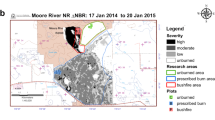Abstract
In the world scenario of declining grassland bird populations, South American species are a particular concern. The Saffron-Cowled Blackbird Xanthopsar flavus is endemic to grasslands in Central and southern South America and its status is vulnerable. Natural history studies stress a number of factors responsible for the decline in its populations. In this paper, we present results from a grassland fire experiment aimed at evaluating the effect of grassland fires on foraging (grasses) and breeding (marshes) habitat use by the Saffron-Cowled Blackbird in a region where fire has been used for centuries as a tool for cattle management. We compare burned grasslands with a control treatment and grasslands within a conservation unit, evaluating uses before and after burning as well as relating bird abundance with environmental characteristics. We found that the Saffron-Cowled Blackbird used the burned treatments more frequently and avoided habitats with tall grasses and developed vegetation. Thus, this species is absent from the conservation unit, which has not experienced fires in nearly three decades. The Saffron-Cowled Blackbird depends on the existence of marshes (breeding habitat) surrounded by short grasses (foraging habitat). In the study region, short grasses are a result of burning practices. As the burning period coincides with the breeding season, the lack of criteria on the part of landowners regarding how to apply and control fire poses a permanent threat to these populations.


Similar content being viewed by others
References
Azpiroz AB (2000) Biologia y conservaci ón del Dragón (Xanthopsar flavus, Icteridae) em la Reserva de Biosfera Bañados del Este. PROBIDES, Rocha
Azpiroz AB, Blake JG (2009) Avian assemblages in altered and natural grasslands in the northern campos of Uruguay. Condor 111:21–35
Behling H, Pillar VDP, Orlóci L, Bauermann SG (2004) Late Quaternary Araucaria forest, grassland (Campos), fire and climate dynamics, studies by high-resolution pollen, charcoal and multivariate analysis of the Cambará do Sul core in southern Brazil. Palaeogeogr Palaeoclimatol Palaeoecol 203:277–297
Belton W (2000) Aves do Rio Grande do Sul: Distribuição e Biologia. Editora Unisinos, São leopoldo
Bilenca D, Miñarro F (2004) Áreas Valiosas de Pastizal en las pampas y campos de Argentina, Uruguay y sur de Brasil (AVPs). Fundación Vida Silvestre Argentina, Buenos Aires
BirdLife International (2007) Species factsheet: Xanthopsar flavus. Downloaded from http://www.birdlife.org on 5/11/2007
Brickle NW, Harper DGC, Aebischer NJ, Cockayne SH (2000) Effects of agricultural intensification on the breeding success of corn buntings Miliaria calandra. J Appl Ecol 37:742–755
Brooks TM, Mittermeier RA, Mittermeier CG, Fonseca AB, Rylands AB, Konstant WR, Flick P, Pilgrim J, Oldfield S, Magin G, Hilton-Taylor C (2002) Habitat loss and extinction in the hotspots of biodiversity. Conserv Biol 16:909–923
Butler SJ, Gillings S (2004) Quantifying the effects of habitat structure on prey detectability and accessibility to farmland birds. Ibis 146(suppl 2):123–130
Collar NJ, Gonzaga LP, Krabbe N, Madroño-Nieto A, Naranjo LG, Parker TA III, Wege DC (1992) Threatened birds of the Americas. ICBP/IUCN, Cambridge
Davis SK (2005) Nest-site selection patterns and the influence of vegetation on nest survival of mixed-grass prairie passerines. Condor 107:605–616
Davis RG, Ormem CDL, Olson V, Thomas GH, Ross SG, Ding T, Rasmussen PC, Stattersfield AJ, Bennett PM, Blackburn TM, Owens IPF, Gaston KJ (2006) Human impacts and the global distribution of extinction risk. Proc R Soc Lond B 273:2127–2133
Devereux CL, McKeever CU, Benton TG, Whittingham MJ (2004) The effects of sward height and drainage on Common Starlings Sturnus vulgaris and Northern Lapwings Vanellus vanellus foraging in grassland habitats. Ibis 146(suppl 2):115–122
Dias RA, Maurício G (2002) Natural History notes and conservation of a Saffron-Cowled Blackbird Xanthopsar flavus population in the southern coastal plain of Rio Grande do Sul, Brazil. Bird Conserv Int 12:255–268
Donald PF, Sanderson FJ, Burfield IJ, van Bommel FPJ (2006) Further evidence of continent-wide impacts of agricultural intensification on European farmland birds, 1990–2000. Agric Ecosyst Environ 116:189–196
Ehrlich PR (1988) The loss of diversity: causes and consequences. In: Wilson EO (ed) Biodiversity. National Academic Press, Washington, pp 27–35
Filloy J, Bellocq MI (2007) Patterns of bird abundance along the agricultural gradient of the pampean region. Agric Ecosyst Environ 120:291–298
Fonseca VSS, Petry MV, Fonseca FLS (2004) A new breeding colony of the Saffron-cowled Blackbird (Xantopsar flavus) in Rio Grande do Sul, Brazil. Ornitol Neotrop 14:1–5
Fontana CS, Bencke GA, Reis RE (2003) Livro vermelho da fauna ameaçada de extinção no Rio Grande do Sul. Edipucrs, Porto Alegre
Fraga RM (2005) Ecology, behavior and social organization of Saffron-Cowled Blackbird (Xanthopsar flavus). Ornitol Neotrop 16:15–29
Fraga RM, Casañas H, Pugnali G (1998) Natural history and conservation of the endangered Saffron-cowled Blackbird Xanthopsar flavus in Argentina. Bird Conserv Int 8:255–267
Fynn RWS, Morris CD, Edwards TJ (2004) Effect of burning and mowing on grass and forb diversity in a long-term grassland experiment. Appl Veg Sci 7:1–10
Harrison S, Inouye BD, Safford HD (2003) Ecological heterogeneity in the effects of grazing and fire on grassland diversity. Conserv Biol 17:837–845
Osborne PL (2000) Tropical ecosystems and ecological concepts. Cambridge University Press, Cambridge
Owens IPF, Bennett P (2000) Ecological basis of extinction risk in birds: habitat loss versus human persecution and introduced predators. Proc Natl Assoc Sci USA 97:12144–12148
Pillar VDP (2003) Dinâmica da expansão florestal em mosaicos de floresta e campos no Sul do Brasil. In: Claudino-Sales V (ed) Ecossistemas Brasileiros: Manejo e Conservação. Expressão Gráfica, Fortaleza, pp 209–216
Pillar VDP (2006) Estado atual e desafios para a conservação dos campos. In: Workshop from Universidade Federal do Rio Grande do Sul. http://www.ecologia.ufrgs.br/ecologia/campos/finalcampos.htm Accessed 20 June 2007
Renfrew RB, Ribic CA, Nack JL (2005) Edge avoidance by nesting grassland birds: a futile strategy in a fragmented landscape. Auk 122:618–636
Ridgely RS, Tudor G (1989) The birds of South America: the oscine passerines. University of Texas Press, Austin
Robinson RA, Hart JD, Holand JM, Parrot D (2004) Habitat use by seed-eating birds: a scale-dependent approach. Ibis 146(suppl 2):87–98
Sanderson FJ, Donald PF, Pain DJ, Burfield IJ, van Bommel FPJ (2006) Long-term population declines in Afro-Palearctic migrant birds. Biol Conserv 131:93–105
Vickery PD, Heckert JR (eds) (1999) Ecology and conservation of grassland birds of the western hemisphere. Studies in Avian Biology 19
Vitousek PM, Mooney HA, Lubchenco J, Melillo JM (1997) Human domination of earth ecosystems. Science 277:494–499
Voss WA, Petry MV, Sander M (1998) Aves do Parque Nacional de Aparados da Serra. Editora Unisinos, São Leopoldo
Warren KA, Anderson JT (2005) Grassland songbird nest-site selection and response to mowing in West Virginia. Wildl Soc Bull 33:285–292
Whelan RJ (1998) The ecology of fire. Cambridge University Press, Cambridge
Whittingham MJ, Evans KL (2004) The effects of habitat structure on predation risk of birds in agricultural landscapes. Ibis 146(suppl 2):210–220
Whittingham MJ, Butler SJ, Quinn JL, Cresswell W (2004) The effect of limited visibility on vigilance behavior and speed of predator detection: implications for conservation of granivorous passerines. Oikos 106:377–385
Acknowledgments
We thank Mr Cláudio Foster for permission to conduct the study on his lands. We acknowledge the Brazilian Institute of Environment and Renewable Natural Resources (IBAMA) for making available installations in the Aparados da Serra National Park during the years of the study and for helping in the fire application so that it was safe and controlled. We also thank our colleagues at the Ornithology Laboratory for their assistance and accompaniment in the field and laboratory work. The fire experiment complied with current Brazilian laws and was authorised by IBAMA and the Department of Forests and Protected Areas (DEFAP/DLF).
Author information
Authors and Affiliations
Corresponding author
Additional information
Communicated by J. Fjieldsâ.
Rights and permissions
About this article
Cite this article
Petry, M.V., Krüger, L. Frequent use of burned grasslands by the vulnerable Saffron-Cowled Blackbird Xanthopsar flavus: implications for the conservation of the species. J Ornithol 151, 599–605 (2010). https://doi.org/10.1007/s10336-009-0489-9
Received:
Revised:
Accepted:
Published:
Issue Date:
DOI: https://doi.org/10.1007/s10336-009-0489-9




